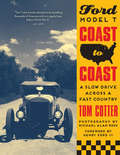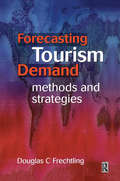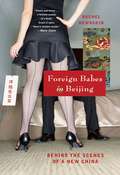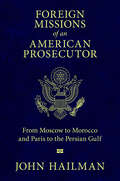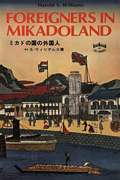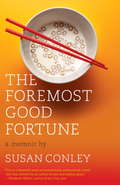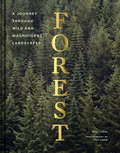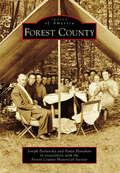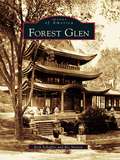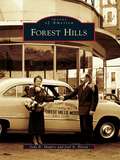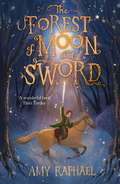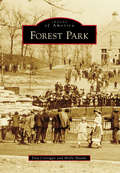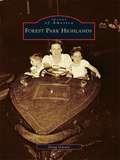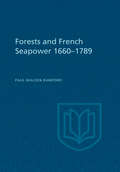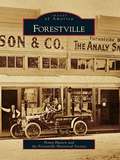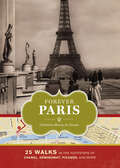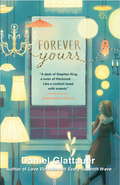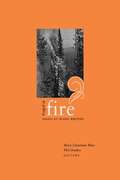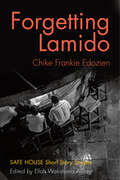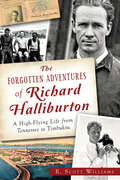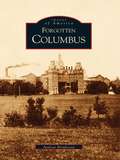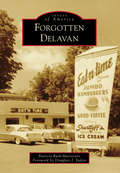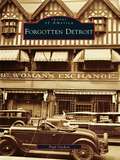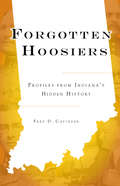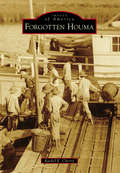- Table View
- List View
Ford Model T Coast to Coast: A Slow Drive Across a Fast Country
by Tom CotterA photo-filled account of traveling the Lincoln Highway in a century-old automobile, and contemplating a future of self-driving cars: "[An] epic road trip." —USA TodayDriverless cars are on the horizon, but before the world falls asleep at the wheel, let's look back down the road from whence we have come. Ford Model T Coast to Coast documents the cross-country adventure of two brave drivers as they pilot a hundred-year-old Model T on a 3,000-mile journey from the Atlantic Ocean to the Pacific Coast.This book is as much a contemplation of early-twentieth-century American life as it is a fond farewell to the automotive age. Can the car still be the vehicle of freedom and discovery when we're no longer in command? Or will we finally be able to fully appreciate the scenery rushing past?Accompanied by Michael Alan Ross' evocative photography, Tom Cotter stops in small towns, meets local people, and hears their stories about cars, travel, and life. The two also explore back roads adjacent to his main route, the Lincoln Highway—the first transcontinental road.Significant cross-country runs, such as those by speed-record setter Cannonball Baker and literary adventurers Jack Kerourac, John Steinbeck, and Bill Bryson, are considered in light of the driverless future. Cotter also drives some of the same roads that a young Edsel Ford traveled in his father's Model T upon high school graduation in 1917. In addition to the central road trip, Cotter visits interesting automotive and transport museums as well as "keepers of the flame" such as Model T clubs, mechanics, junkyards, and collectors across the country. He also records the numerous trials and tribulations in keeping a very old car operating on a very long journey—something the driverless car of the future is unlikely to encounter.
Forecasting Tourism Demand: Methods And Strategies
by Douglas Frechtling'Forecasting tourism demand' is a text that no tourism professional can afford to be without. The tourism industry has experienced an overwhelming boom over recent years, and being able to predict future trends as accurately as possible is vital in the struggle to stay one step ahead of the competition. Building on the success of 'Practical Tourism Forecasting' this text looks at 13 methods of forecasting and with a user friendly style, 'Forecasting Tourism Demand' guides the reader through each method, highlighting its strengths and weaknesses and explaining how it can be applied to the tourism industry.'Forecasting Tourism Demand' employs charts and tables to explain how to:* plan a forecasting project* analyse time series and other information* select the appropriate forecasting model* use the model for forecasting and evaluate its resultsIdeal for marketing managers and strategic planners in business, transportation planners and economic policy makers in government who must project demand for their products among tourists. Executives who rely on forecasts prepared by others will find it invaluable in assisting them to evaluate the validity and reliability of predictions and forecasts. Those engaged in analysing business trends will find it useful in surveying the future of what has been called the largest industry in the world.
Foreign Babes in Beijing: Behind the Scenes of a New China
by Rachel Dewoskin"For a real insider's look at life in modern China, readers should turn to Rachel DeWoskin."--Sophie Beach, The Economist Determined to broaden her cultural horizons and live a "fiery" life, twenty-one-year-old Rachel DeWoskin hops on a plane to Beijing to work for an American PR firm based in the busy capital. Before she knows it, she is not just exploring Chinese culture but also creating it as the sexy, aggressive, fearless Jiexi, the starring femme fatale in a wildly successful Chinese soap opera. Experiencing the cultural clashes in real life while performing a fictional version onscreen, DeWoskin forms a group of friends with whom she witnesses the vast changes sweeping through China as the country pursues the new maxim, "to get rich is glorious." In only a few years, China's capital is transformed. With "considerable cultural and linguistic resources" (The New Yorker), DeWoskin captures Beijing at this pivotal juncture in her "intelligent, funny memoir" (People), and "readers will feel lucky to have sharp-eyed, yet sisterly, DeWoskin sitting in the driver's seat"(Elle).
Foreign Missions of an American Prosecutor: From Moscow to Morocco and Paris to the Persian Gulf
by John HailmanIn his fifth book, John Hailman recounts the adventures and misadventures he experienced during a lifetime of international travel. From Oman to Indonesia, from sandstorms and food poisoning to gangsters and at least one jealous husband, Hailman explores the cultures and court systems of faraway countries. The international story begins in Paris as a young Hailman, a student at La Sorbonne, experiences the romance and excitement one expects from the City of Lights. Years later Hailman returns to France, to Interpol Headquarters in Lyon where he received his international law certificate from the National School for Magistrates. Traveling the world as a representative for the US Justice Department, Hailman encountered criminals and conspiracies, including a plot in Ossetia, Georgia, to hijack his helicopter and kidnap him. From his time as a prosecutor are tales of three very different Islamic cultures in the colorful societies and legal systems of Tunisia, Algeria, and Morocco. Hailman also travels to the chaotic world of the former Soviet Union where, at the time of his visit, a new world of old countries was trying to rediscover independent pasts. He explores the tiny country of Moldova and the beautiful and picturesque Republic of Georgia, and visits Russia during the brief period democracy was flowering and the nation was experimenting with a new jury trial system. Viewing his adventures through the lens of laws and customs, Hailman is able to give unique insight to the countries he visits. With each new adventure in Foreign Missions of an American Prosecutor, John Hailman shares his passion for travel and his fascination with other cultures.
Foreigners in Mikadoland
by Harold S. WilliamsThis is an account of life in the foreign communities and former Foreign Settlements or Concessions in Japan that flourished after Japan was opened to foreign trade in 1859. It tells of the imposters, the eccentrics, and the scandals, no less than the achievements of the scholars, the merchants, and the diplomats who contributed so much to the development of modern Japan.Here you will meet Townsend Harris, the first U.S. Consul General to Japan, the Grand Duke Alexander, and many other less well known, but just as interesting figures such as the energetic Rev. Bailey, the remarkable Mr. McLeod, and the Misses Butterfly and Chrysanthemum.All these events are portrayed in a series of chapters, arranged as nearly as possible in chronological order, each woven around some of the happenings of those times. Carefully researched, all of these events are historically accurate in every detail, and are written in Mr. Williams' highly enjoyable style.
The Foremost Good Fortune
by Susan ConleySusan Conley, her husband, and their two young sons say good-bye to their friends, family, and house in Maine for a two-year stint in a high-rise apartment in Beijing, prepared to embrace the inevitable onslaught of new experiences that such a move entails. But Susan can’t predict just how much their lives will change. While her husband is consumed with his job, Susan works on finishing her novel and confronting the challenges of day-to-day life in an utterly foreign country: determining the proper way to buy apples at a Chinese megamarket; bribing her little boys to ride the school bus; fielding invitations to mysterious “sweater parties” and tracking down the faux-purse empire of the infamous Bag Lady; and getting stuck in an elevator, unable to call for help in Mandarin. Despite the distractions, there are many occasions for joy. From road trips to the Great Wall and bartering for a “starter Buddha” at the raucous flea market to lighting fireworks in the streets for the Chinese New Year and feasting on the world’s best dumplings in back-alley restaurants, they gradually turn their unfamiliar environs into a true home. Then Susan learns she has cancer. After undergoing treatment in Boston, she returns to Beijing, again as a foreigner—but this time, it’s her own body in which she feels a stranger. Set against the eternally fascinating backdrop of modern China and full of insight into the trickiest questions of motherhood—How do you talk to children about death? When is it okay to lie?—this wry and poignant memoir is a celebration of family and a candid exploration of mortality and belonging.
Forest: Walking Among Trees
by Matt CollinsBrimming with engaging writing and stirring photography, Forest is an ode to the natural world and a celebration of the relationship between humans and trees.Discover the secrets hidden within the Earth's lush woodlands and wild landscapes through photographs and stories about enchanting forests, magnificent trees, and people who live off the land.Journeying across North America, the United Kingdom, and Europe, writer Matt Collins and photographer Roo Lewis capture the history, science, and human stories behind some of the most enchanting natural environments in the world. • Explores the captivating history behind some of the world's most enchanting forests• Organized by tree species, including the hearty pines in Spain's Tamada forest, the towering firs of the American West, the striking Birch groves of Germany's Elbe Valley, and beyond• A blend of beautiful photographs, scientific trivia, and engaging human storiesForest is an arresting tribute to the magnificence of the natural world and a wonderful gift for anyone who enjoys spending time in the outdoors.Complete with gorgeous photography and engaging stories of people living in harmony with nature, readers will learn everything they dream of knowing about the forests of the world. • A handsome gift for photographers, travel and outdoor enthusiasts, environmentalists, and science lovers• A stunning way to learn about the world and the trees that surround us• Great for readers who couldn't get enough of The Hidden Life of Trees by Peter Wohlleben, Ancient Trees by Beth Moon, and Wise Trees by Diane Cook and Len Jenshel
Forest County (Images of America)
by Joseph Pavlansky Paula Hanahan The Forest County Historical SocietyLocated within the western lands of Pennsylvania’s vast wilderness and rolling mountains, Forest County is known for its natural beauty and industrial history. With the Allegheny National Forest dominating the locale, Forest County is the third least populated county in Pennsylvania. Being recognized as an excellent place for outdoor adventures, the county is also known for its simplicity and for not having one traffic light within its boundaries. Over time, many have come to Forest County seeking opportunity and prosperity. When the surrounding counties were experiencing an oil boom, Forest County was exploring the lumber industry and dominating the business. To the hunters and fisherman that settled in Forest County, the wilderness was a utopia ripe with panther, deer, bear, wolves, bass, salmon, trout, and pike. The area is still revered for its vast wilds, which lend themselves to various recreational activities throughout the year.
Forest Glen (Images of America)
by Rich Schaffer Ric NelsonForest Glen, Maryland, a sleepy suburb of Washington, D.C., has weathered the arrival of the railroad, construction of a summer resort, development of a fashionable girl's finishing school, and the establishment of a U.S. Army base. Throughout these times there has always been a close-knit community of homes and people that were often overshadowed by the many diverse events and changes that prevailed here. The focal point of the community--one of only a few extant eclectic architectural follies in the United States and consisting of many international styles--is listed on the National Register of Historic Places as the National Park Seminary Historic District.
Forest Hills (Images of America)
by Joel A. Bloom Jody B. ShapiroAptly named because of its hilly terrain and abundance of trees, the area now known as Forest Hills was a dusty coal mining community in the late 1800s. Centered between two major roads, the Lincoln Highway (Ardmore Boulevard/U.S. Route 30) and the Greensburg Pike, Forest Hills was incorporated in 1919 in order to gain better representation for tax money. Technology put the town on the map with the first commercial licensed radio station broadcast in 1920 and the Westinghouse Atom Smasher, built in 1937. As the borough grew with new houses, schools, and parks, so did traditions such as the Fourth of July celebration at Forest Hills Park and the Bryn Mawr Corn Roast. Many who live in the community are third or fourth generation residents. Using vintage photographs, Forest Hills presents the untold story of this tight-knit community.
The Forest of Moon and Sword
by Amy Raphael"A sumptuously imagined children's debut" The Telegraph"A fast paced; single minded adventure. Female bravery is a given" The Observer When Art's mother is accused of witchcraft and captured, she is determined to get her back - at any cost. A lyrical adventure with folklore at its heart, for fans of THE HOUSE WITH CHICKEN LEGS.Twelve-year-old Art lives in a small village in Scotland. Her mother has always made potions that cure the sick, but now the townspeople say she is a witch. One cloudless night, Art's mother is arrested and taken to England. Art mounts her horse, taking a sword, a tightrope, and a herbal recipe book, and begins a journey through wild forests, using nature's signs and symbols to guide her.But will she spot the signs from the omens? Will she reach her mother, before it's too late?'A wonderful book' - Piers Torday'Very exciting' - Anthony McGowan 'Thrilling and uplifting' - Frank Cottrell-Boyce 'Gripping. I raced through it' - A.M. Howell
Forest Park (Images of America)
by Don Corrigan Holly ShanksAt 1,293 acres, Forest Park exceeds the size of New York’s Central Park by nearly 500 acres, and within are lakes, hills, wetlands, woodlands, and bountiful recreational opportunities. Within a few decades of its 1876 opening, Forest Park became the host for the 1904 St. Louis World’s Fair, as well as the 1904 Summer Olympics. Known as the “Heart of St. Louis,” the park features amazing attractions, such as the Saint Louis Zoo, the Saint Louis Art Museum, the Missouri History Museum, The Muny, and the Saint Louis Science Center. Millions of Americans have come to Forest Park for world-class festivities and for celebrations of heroes, from Lewis and Clark to explorers of outer space. Today, the park continues to host remarkable events, including Fair St. Louis, Earth Day, Shakespeare in the Park, and LouFest.
Forest Park Highlands
by Doug GarnerForest Park Highlands was once St. Louis's largest and best-known amusement park. In its earliest years, the Highlands boasted a fine theater and one of the largest public swimming pools in the United States. After the 1904 world's fair closed, several attractions found a new home at the Highlands; the large pagoda--a re-creation of the temple of Nekko, Japan--served as the park's bandstand for several years. Roller coasters are the lifeline of every good amusement park, and the Highlands always had two. The end came for the Highlands in a spectacular fire that decimated almost the entire park on July 19, 1963. Only the Comet roller coaster, the Ferris wheel, the Dodgems, the carousel, and the Aero Jets survived. Forest Park Highlands covers other historic amusement parks in St. Louis as well, starting with the earliest, West End Heights, and ending with Holiday Hill, the last remaining park.
Forests and French Sea Power, 1660-1789
by Paul Walden BamfordBy choosing to concentrate upon discovering what forest resources were available to the French navy during the ancien régime and what use it was able to make of them, Mr. Bamford has not only provided the first monograph on that subject in the English language, but has gone far toward explaining why France was the loser in the long duel with England for the control of commerce and the extension of empire. <P><P> Two years of research in the Archives Nationales and in the Archives de la Marine in Paris, Toulon, and Rochefort enabled him to draw on contemporary sources of information of which little, if any, use has been made before, and a further year of research in the libraries of New York City, particularly in the rich Proudfit Naval Collection, also yielded new material. It is Mr. Bamford's achievement to have handled this vast store of primary sources with such skill and judgement that the reader, by turning over letters from disgruntled forest proprietors, reports from harassed maîtres on the trickery and recalcitrance of the peasants, instructions from the top echelon of the navy to inspectors in the forests, and a variety bills, receipts, and memoranda, is given at first hand an appreciation of the difficulties faced by the navy in trying to obtain timber and masts of the choice quality required for building ships-of-the-line. The navy had to compete with the merchant marine and with industrial and private users of fuel for supplies that were continually being depleted by mismanagement and by the conversion of forests to arable land. Measures, superficially admirable, for conserving the forests are found on closer examination to be at once over-precise and not properly enforced. Transport, even in a country so abundantly supplied with navigable rivers as France, was expensive and difficult.<P>Not only historians, but scholars in the field of forestry, economics, geography, agriculture, and transport will find this book illuminating.
Forestville
by Forestville Historical Society Penny HuttenVisitors to Forestville are taken aback by its picturesque valleys laden with roaming vineyards. However, Forestville is more than a gateway to the Russian River; it is a diverse array of businesses, wineries, farming, and recreation. Forestville grew from the Spanish land grant traded by Capt. Juan Bautista Rogers Cooper from his brother-in-law Gen. Mariano Vallejo in 1834 into the town known by passing travelers as "Swindle Rig." In 1867, the town was named Forestville after Andrew Jackson Forrister, a saloon owner. It was set apart from other settlements by having the first powered sawmill in California and the Faudré Chair factory, the largest manufacturing plant in Sonoma County of that era. Collectors still seek out the factory's rawhide-bottom chairs. As a popular stop on the railway line, many vacationers from San Francisco passed through on their journeys to the Russian River. In 1963, the town continued to be different, setting aside land for a community youth park, so it is no wonder the town's slogan is "Forestville the Great Life."
Forever Paris: 25 Walks in the Footsteps of Chanel, Hemingway, Picasso, and More
by Christina Henry de TessanTake a stroll through Édith Piaf's Belleville, dine at Napoléon's favorite restaurant, and explore the late-night haunts of Ernest Hemingway, Josephine Baker, and Pablo Picasso. From the author of the best-selling City Walks: Paris deck, this lively collection of walking adventures follows in the footsteps of more than 25 of the city's iconic former residents. Throughout, Paris is seen from the intimate vantage point of those who loved it best, from the bars where authors penned classic works to the markets and patisseries where food lovers indulged. Including photos and full-color maps throughout, each walk in this book guides visitors and locals through the city that inspired some of the world's most famous artists, writers, chefs, musicians, politicians, and more.
Forever Yours
by Daniel GlattauerJudith, in her mid-thirties and single, meets Hannes when he steps on her foot in a crowded supermarket. Before long he turns up in the exclusive little lighting boutique that Judith runs with the help of her assistant Bianca. Hannes is an architect - single and in the prime of life. Not only is he every mother-in-law's dream, but Judith's friends are also bowled over by him. At first Judith revels in being put on a pedestal by this determined man who seems to have eyes only for her. But as time goes by, she finds his constant displays of affection increasingly wearying and his intensive attention becomes oppressive and overwhelming. In the end she feels cornered, controlled and stifled. All her attempts to get him out of her life fail. He seems to follow her all the way into her dreams, and when she wakes up he's already waiting on her doorstep to pamper her afresh...
Forged in Fire: Essays by Idaho Writers
by Mary Clearman Blew Phil DrukerIn these 20 essays Idaho writers describe the role of fire in their lives and experience and their emotional responses to fire in its various forms whether amongst the trees or on the high plateaus, at the banks of rivers, or up against the encroachment of the urban. Along with new writers are prize-winners Kim Barnes ("The Ashes of August") and Robert Coker Johnson ("What I Know of Fire"), signaling a surge of talent is rising from the flames in Idaho. Annotation ©2005 Book News, Inc., Portland, OR (booknews.com)
Forgetting Lamido
by Chike Frankie Edozien Ellah Wakatama AllfreyIlluminating African narratives for readers both inside and outside the continent. Representing the very best of African creative nonfiction, Safe House brings together works from Africa's contemporary literary greats. In a collection that ranges from travel writing and memoir to reportage and meditative essays, editor Ellah Wakatama Allfrey has brought together some of the most talented writers of creative nonfiction from across Africa. This creative nonfiction single from the Safe House anthology is Chike Frankie Edozien's writing of a lost love and the burden of silence.
The Forgotten Adventures of Richard Halliburton: A High Flying Life from Tennessee to Timbuktu
by R. Scott WilliamsA biography of the charismatic world traveler whose daredevil exploits thrilled millions in the early twentieth century. Born in 1900, Richard Halliburton ran away from his hometown of Memphis, Tennessee, at the age of nineteen to lead an extraordinary and dramatic life of adventure. Against the backdrop of the Roaring Twenties and the Great Depression, Halliburton&’s exploits around the globe made him an internationally known celebrity and the most famous travel writer of his time. From climbing Mount Olympus in Greece to swimming the Panama Canal and flying all the way to Timbuktu, Halliburton experienced and wrote about adventures that others never even believed possible. His youthful spirit and bohemian lifestyle won the hearts of millions, and this absorbing biography tells his story. &“He was Marco Polo and Indiana Jones wrapped up in one, with P.T. Barnum&’s flippancy and James Bond&’s bravado, capped off by F. Scott Fitzgerald&’s aristocratic good looks and manners.&” —Smithsonian &“A concise new biography [that] covers the life of a man of marvels.&” —Memphis Magazine
Forgotten Columbus (Images of America)
by Andrew HendersonColumbus, Ohio, "an odd amalgam of the planned and the spontaneous," was founded on the banks of the Scioto River in 1812 as the new seat of this young state's government. Located in the wilderness of central Ohio, nearly equidistant to the "real" cities of Cincinnati, Cleveland, and Toledo, Columbus experienced 100 years of unprecedented growth from which it would emerge the state's capital in more than title alone. Today, it is Ohio's largest city. Forgotten Columbus features many people, places, and events that defined this burgeoning 19th and early-20th century city. And above all, the places--from the Old Ohio Penitentiary, to Fort Hayes, to the recently revitalized Brewery District--which either no longer exist, or have changed so dramatically over the years that they are barely recognizable. Residents and visitors alike will find this a fascinating, insightful, and at times surprising look back at a forgotten era in Columbus's history.
Forgotten Delavan
by Douglass J. Yadon Patricia Ruth-MarsicanoWhen they left New York in 1836, brothers Henry and Samuel Phoenix intended to establish a temperance colony where inhabitants could live a life free from "demon alcohol." They found the perfect location in the Wisconsin Territory and named it Delavan after temperance leader and abolitionist Edward C. Delavan. The Phoenixes purchased 400 acres of land to sell to friends and family back in New York. The population soon boomed thanks to people like themselves who embraced the belief in an alcohol- and slavery-free society. All deeds were written with covenants prohibiting alcohol, but in 1845 the covenants were deemed unconstitutional. Since then, Delavan has been home to abolitionists, circus performers, and artists. It has drawn tourists from around the Midwest to its ballrooms, resorts, steamers, and beautiful lake. From Delavan's humble beginnings, the community has continued to grow to a population of more than 13,000, and today Delavan thrives on its industry, agriculture, and tourism.
Forgotten Detroit (Images of America)
by Paul VachonDetroiters know their history well. Founded in 1701 by Antoine de la Mothe Cadillac, the city subsisted on a variety of industries: fur trading, stove building, and, of course, the automobile. Names such as Henry Ford and Charles Lindbergh resonate in Detroiters' common memory. Detroit's meteoric rise during the 20th century established the city as an influential leader in commerce, culture, and religion. This growth spawned the development of numerous businesses, organizations, and institutions, many now forgotten. Albert Kahn left his indelible mark. Mary Chase Stratton created a new art form. And Henry Ford II changed the course of his family legacy. Forgotten Detroit delves into the wellspring of history to retell some of these lesser-known stories within Detroit's rich heritage.
Forgotten Hoosiers: Profiles from Indiana's Hidden History
by Fred D. CavinderVowing to overcome the sin of seriousness, Indiana-born humorist Don Herold lived up to his promise. Gifted with a droll sense of humor and a vivid imagination, he was one of the most widely read, if least remembered, Hoosiers. In Forgotten Hoosiers, journalist Fred D. Cavinder presents a collection of biographical sketches charting the lives of noteworthy Hoosiers who have been overlooked, as well as acclaimed figures whose Hoosier origins have been obscured. From Harland David Sanders, the pioneering Kentucky colonel who developed the world-famous chicken franchise, to Samuel G. Woodfill, whom many have called the greatest hero of World War I, Hoosiers- both known and unknown- have continued to make their marks across the country and the world.
Forgotten Houma
by Rachel E. CherryHouma officially became the seat of Terrebonne Parish in 1848; however, the area known as "terre bonne" ("the good earth") was inhabited much earlier. The Houma tribe settled the land as early as 1760, Arcadian French settlers arrived by 1785, Spanish settlers by 1790, and wealthy English landowners established the area's first plantations in 1828. Agriculture, hunting, and fishing activities such as oyster harvesting and shrimp drying were prominent occupations in the parish until the oil and gas industry took hold of the economy in the 1920s. Seemingly endless waterways, marshes, and bays, coupled with fertile farmland and oil production, helped foster Houma's lucrative economy; likewise, a blend of customs, traditions, and natural disasters have shaped its unique culture. Forgotten Houma uses vintage photographs to capture the community before modernization and destruction, awakening the spirits of former residents and the memories of earlier ways of life.
